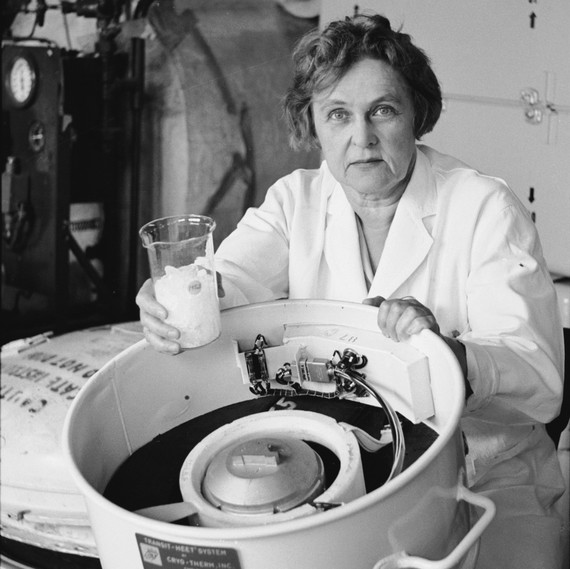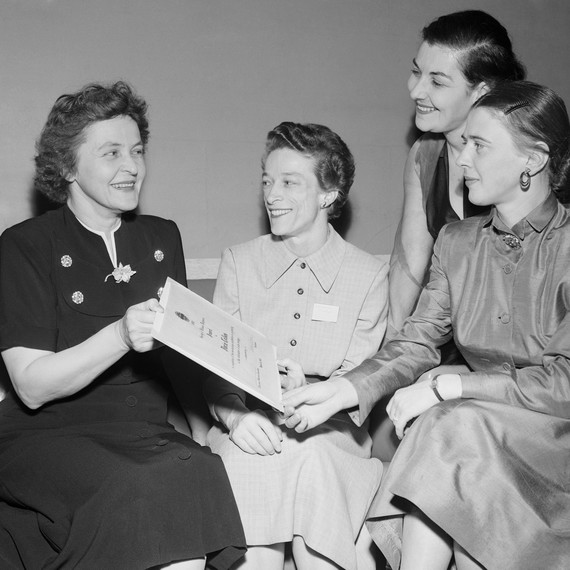你可以感谢Maria Telkes太阳能的日常使用

玛丽亚特尔克斯对太阳能的迷恋始于20世纪初的匈牙利,从未动摇过。物理化学家和生物物理学家致力于利用其能源,发明了第一个成功的太阳能加热系统,太阳能烤箱和太阳能水蒸馏系统,用于制造海水饮用水。 Telkes在变得至关重要之前就意识到需要替代形式的电力。 “太阳光迟早会被用作能量来源,为什么还要等?”她说,作为一个崭露头角的科学家.
Telkes于1900年出生于匈牙利。她在布达佩斯大学攻读文学学士学位,并从那里获得物理化学博士学位。 25岁时,她已经获得博士学位,移民到美国。她最初在克利夫兰诊所基金会担任生物物理学家,创建了一个记录脑电波的光电设备。然后她搬到了西屋电气公司,在那里她开发了将热能转化为电能的仪器。 1937年,她成为美国公民,几年后她加入了太阳能转换项目,她的专业重点终于成为太阳 – 她真正热爱的主题,以及她如何赢得她的绰号,太阳女王.
不久之后,美国军方注意到她在新兴太阳能领域的专业知识,并指望她参与一个对第二次世界大战和在太平洋发动的战斗产生重大影响的项目。随着海上的所有战斗,美国士兵有可能在没有淡水的情况下被困在炎热和潮湿的环境中数天。 Telkes开发了一种小巧轻便的设备,利用太阳的热量来蒸馏所有紧急医疗包中的水.
[学习:如何在家节约能源]

Maria Telkes博士(左)获得了女工程师协会颁发的工程优秀贡献奖.
同样在麻省理工学院,1948年,Telkes完成了Dover Sun House–可能是她最着名的项目 – 一个展示太阳能的力量的实验家园,并解决了如何储存它的问题。这是第一个完全由太阳能加热的家庭,在盐中捕获和储存太阳能,然后在整个冬季的阴天将其分配通过房屋。值得注意的是,她的合作伙伴是两位女性,建筑师Eleanor Raymond和金融家Amelia Peabody。 1950年,Telkes和雷蒙德参加麻省理工学院举办的一场名为“太阳能空间供暖”的前瞻性研讨会。人们和报纸都不能停止谈论Dover House及其由女性建造的事实(在一个98人的客人名单上,他们是三个女性中的两个) – 你可以说它是在阳光下的那一刻.
项目结束后,Telkes继续开展太阳能加热工作。 1953年,她受福特基金会委托创建了一个太阳能烤箱,可以供所有纬度居住的人使用。在发明这种烤箱的同时,她还为农民开辟了一种更快的方式来干燥他们的庄稼。她后来致力于开发能够承受太空极端温度的材料,并与美国能源部合作,在马萨诸塞州的卡莱尔建造了世界上第一座太阳能电力住宅。即使在她退休后,她还是继续咨询许多太阳能初创公司,直到她去世,享年94岁.
在她辉煌的职业生涯中,Telkes获得了许多着名的奖项,并获得了20多项专利。 2012年,她入选全国发明家名人堂,并在全国各地以众多学校命名。太阳能作为寻求可再生能源的领跑者继续发展,而Telkes将永远是太阳女王.

27.04.2023 @ 15:49
As an AI language model, I do not have a personal opinion, but I can provide a translation of the text from Chinese to English.
Photography: Alfred Eisenstaedt / Getty Maria Telkes fascination with solar energy began in Hungary in the early 20th century and has never wavered. The physical chemist and biophysicist devoted herself to harnessing its energy, inventing the first successful solar heating system, solar ovens, and solar distillation systems for making seawater potable. Telkes realized the need for alternative forms of electricity long before it became critical. “Solar energy will eventually be used as an energy source, so why wait?” she said, as a budding scientist.
Telkes was born in Hungary in 1900. She earned a bachelors degree in literature from Budapest University and a Ph.D. in physical chemistry from there. By the age of 25, she had earned her doctorate and immigrated to the United States. She initially worked as a biophysicist at the Cleveland Clinic Foundation, creating a photoelectric device to record brain waves. She then moved to Westinghouse Electric, where she developed instruments that converted heat energy into electrical energy.
In 1937, she became a U.S. citizen, and a few years later, she joined the solar conversion project, where her specialty finally became the sun – the subject she truly loved, and how she earned her nickname, the Sun Queen.
Soon after, the U.S. military took notice of her expertise in the emerging field of solar energy and relied on her to participate in a project that would have a significant impact on World War II and the battles waged in the Pacific. With all the fighting at sea, American soldiers could be stranded in hot and humid environments for days without fresh water. Telkes developed a small, lightweight device that used the suns heat to distill water from all the emergency medical kits.
At MIT in 1948, Telkes completed the Dover Sun House – perhaps her most famous project – an experimental home that showcased the power of solar energy and solved the problem of how to store it. It was the first home entirely heated by solar energy, capturing and storing the suns energy in salt and distributing it throughout the house on cloudy days throughout the winter. It is worth noting that her partners were two women, architect Eleanor Raymond and financier Amelia Peabody.
In 1950, Telkes and